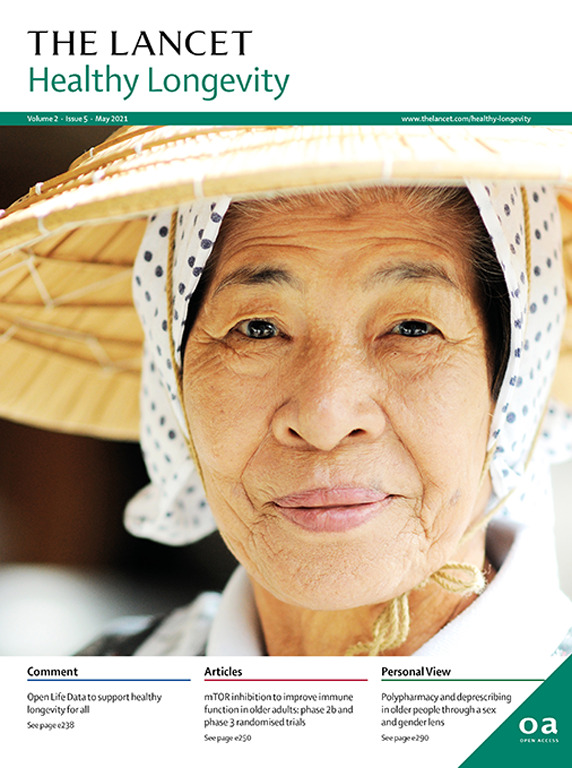应用深度学习标记对视网膜照片中的发病率和死亡率进行预测:队列开发和验证研究。
IF 13.4
Q1 GERIATRICS & GERONTOLOGY
引用次数: 0
摘要
背景:生物老化标志物比计时年龄更有助于对发病率和死亡率进行风险分层。在本研究中,我们旨在利用视网膜图像和表型年龄的复合生物标志物 PhenoAge,开发一种基于深度学习的新型生物老化标志物(以下简称为 RetiPhenoAge):我们使用英国生物库数据集中的视网膜照片来训练一种深度学习算法,以预测 PhenoAge 的综合得分。我们使用多层深度卷积神经网络架构来开发基于深度学习的生物年龄标记,即 RetiPhenoAge,目的是识别视网膜中与肾脏、免疫、肝功能、炎症和能量代谢相关的血液生物标记物的变化以及实际年龄有关的模式和特征。我们在三个独立的队列(英国生物库、新加坡眼病流行病学研究[SEED]和美国年龄相关眼病研究[AREDS])中确定了这一生物老化标志物在预测发病率(心血管疾病和癌症事件)和死亡率(全因、心血管疾病和癌症)方面的性能。我们还比较了 RetiPhenoAge 与另外两个已知的老化生物标志物(手部握力和调整后的白细胞端粒长度)和一个生活方式因素(体育锻炼)在死亡率和发病率风险分层方面的表现。我们通过评估 RetiPhenoAge 与不同系统特征(如糖尿病或高血压)和血液代谢物水平的关联,探索了 RetiPhenoAge 的潜在生物学特性。我们还进行了一项全基因组关联研究,以确定与 RetiPhenoAge 相关的遗传变异,随后进行了表达量性状位点图绘制、基于基因的分析和基因组分析。研究采用 Cox 比例危险模型来估算 RetiPhenoAge 与不同发病率和死亡率之间关系的危险比(HRs)和相应的 95% CI:34 061 名英国生物库参与者的视网膜照片被用于训练模型,SEED 队列中 9429 名参与者和 AREDS 队列中 3986 名参与者的数据被纳入研究。RetiPhenoAge与全因死亡率(HR 1-92 [95% CI 1-42-2-61])、心血管疾病死亡率(1-97 [1-02-3-82])、癌症死亡率(2-07 [1-29-3-33])和心血管疾病事件(1-70 [1-17-2-47])相关,与PhenoAge和其他可能的混杂因素无关。在两个独立的队列中也发现了类似的结果(SEED 的心血管疾病死亡率 HR 为 1-67 [1-21-2-31],AREDS 为 2-07 [1-10-3-92])。与手部握力、端粒长度和体力活动相比,RetiPhenoAge 与死亡率和发病率的关系更为密切。我们发现了两个与 RetiPhenoAge 显著相关的基因变异(单核苷酸多态性 rs3791224 和 rs8001273),它们与心脏、肾脏和大脑等不同组织的表达量性状位点相关:我们新的深度学习衍生生物老化标记是预测死亡率和发病率结果的可靠指标,可用作测量老化的新型无创方法:新加坡国家医学研究理事会和新加坡科技研究局。本文章由计算机程序翻译,如有差异,请以英文原文为准。
Application of a deep-learning marker for morbidity and mortality prediction derived from retinal photographs: a cohort development and validation study
Background
Biological ageing markers are useful to risk stratify morbidity and mortality more precisely than chronological age. In this study, we aimed to develop a novel deep-learning-based biological ageing marker (referred to as RetiPhenoAge hereafter) using retinal images and PhenoAge, a composite biomarker of phenotypic age.
Methods
We used retinal photographs from the UK Biobank dataset to train a deep-learning algorithm to predict the composite score of PhenoAge. We used a deep convolutional neural network architecture with multiple layers to develop our deep-learning-based biological ageing marker, as RetiPhenoAge, with the aim of identifying patterns and features in the retina associated with variations of blood biomarkers related to renal, immune, liver functions, inflammation, and energy metabolism, and chronological age. We determined the performance of this biological ageing marker for the prediction of morbidity (cardiovascular disease and cancer events) and mortality (all-cause, cardiovascular disease, and cancer) in three independent cohorts (UK Biobank, the Singapore Epidemiology of Eye Diseases [SEED], and the Age-Related Eye Disease Study [AREDS] from the USA). We also compared the performance of RetiPhenoAge with two other known ageing biomarkers (hand grip strength and adjusted leukocyte telomere length) and one lifestyle factor (physical activity) for risk stratification of mortality and morbidity. We explored the underlying biology of RetiPhenoAge by assessing its associations with different systemic characteristics (eg, diabetes or hypertension) and blood metabolite levels. We also did a genome-wide association study to identify genetic variants associated with RetiPhenoAge, followed by expression quantitative trait loci mapping, a gene-based analysis, and a gene-set analysis. Cox proportional hazards models were used to estimate the hazard ratios (HRs) and corresponding 95% CIs for the associations between RetiPhenoAge and the different morbidity and mortality outcomes.
Findings
Retinal photographs for 34 061 UK Biobank participants were used to train the model, and data for 9429 participants from the SEED cohort and for 3986 participants from the AREDS cohort were included in the study. RetiPhenoAge was associated with all-cause mortality (HR 1·92 [95% CI 1·42–2·61]), cardiovascular disease mortality (1·97 [1·02–3·82]), cancer mortality (2·07 [1·29–3·33]), and cardiovascular disease events (1·70 [1·17–2·47]), independent of PhenoAge and other possible confounders. Similar findings were found in the two independent cohorts (HR 1·67 [1·21–2·31] for cardiovascular disease mortality in SEED and 2·07 [1·10–3·92] in AREDS). RetiPhenoAge had stronger associations with mortality and morbidity than did hand grip strength, telomere length, and physical activity. We identified two genetic variants that were significantly associated with RetiPhenoAge (single nucleotide polymorphisms rs3791224 and rs8001273), and were linked to expression quantitative trait locis in various tissues, including the heart, kidneys, and the brain.
Interpretation
Our new deep-learning-derived biological ageing marker is a robust predictor of mortality and morbidity outcomes and could be used as a novel non-invasive method to measure ageing.
Funding
Singapore National Medical Research Council and Agency for Science, Technology and Research, Singapore.
求助全文
通过发布文献求助,成功后即可免费获取论文全文。
去求助
来源期刊

Lancet Healthy Longevity
GERIATRICS & GERONTOLOGY-
CiteScore
16.30
自引率
2.30%
发文量
192
审稿时长
12 weeks
期刊介绍:
The Lancet Healthy Longevity, a gold open-access journal, focuses on clinically-relevant longevity and healthy aging research. It covers early-stage clinical research on aging mechanisms, epidemiological studies, and societal research on changing populations. The journal includes clinical trials across disciplines, particularly in gerontology and age-specific clinical guidelines. In line with the Lancet family tradition, it advocates for the rights of all to healthy lives, emphasizing original research likely to impact clinical practice or thinking. Clinical and policy reviews also contribute to shaping the discourse in this rapidly growing discipline.
 求助内容:
求助内容: 应助结果提醒方式:
应助结果提醒方式:


